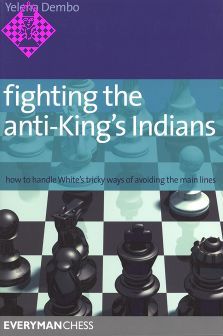Article Number
LODEMFTAKI
Author
Fighting the Anti-King's Indian
206 pages, paperback, Everyman, 1. edition 2008
" I love playing the King's Indian, but no-one ever allows me to reach my favourite opening! " Does this sound like an all too familiar complaint? The answer to this problem lies here. The truth is you will reach your favourite opening in barely half the games you play against 1 d4, and that's why this book is a godsend to those players fed up with blindly searching for the right way to play against these annoying White systems designed to avoid the main lines: the Trompowsky; the London System; the Torre Attack; the Barry Attack; the Colle System; the Veresov; the Blackmar-Diemer Gambit - the list goes on and on! Yelena Dembo, who as a hardened King's Indian and Grünfeld player has considerable experience facing these irritating openings, deals with them in no uncertain terms, in each case offering Black a no-nonsense solution that enables you to face the future with confidence.
·Covers all of White's possibilities
·Also includes King's Indian and Grünfeld solutions to 1 Nf3 and 1 c4
·Written by an renowned opening expert
Yelena Dembo is an International Master from Greece with numerous tournament successes to her name, including the bronze medal at the 2005 European Women's Championship and one Grandmaster norm. She's a renowned chess coach, who has taught students from over 30 countries. She's also an experienced chess writer and a regular contributor to the quality publication Chess Informant. This is her second book for Everyman Chess, a follow-up to Play the Grünfeld.Preface
The King's Indian and the Grünfeld are two of Black's most dynamic and combatdefences to 1 d4. Nowadays one needs to be armed with a lot of complex thein order to successfully tackle them and even then success is not guaranteed. Thus it is not surprising that many white players, especially at lower and amateur levels, often deviate from the main paths after 1 d4 Nf6, preferring to omit an early c2-c4 and to avoid the King's Indian and the Grünfeld altogether.
This book aims to provide the reader with a complete, well-researched and sound repertoire against all these anti-King's Indian and anti-Grünfeld systems. More specifically, it covers all the established opening set-ups White can employ after 1 d4 Nf6, provided that he refrains from playing c4 at an early stage - that would transpose back to our beloved openings! In addition, you will find at the end a couple of chapters discussing move order issues relating to the English Opening. While this material is strictly outside the range of the anti-King's Indiit is of such great practical significance to King's Indian and Grünfeld players that I felt I had to give it the attention it deserves.
I must admit that the title of this book is not entirely accurate! That's because some Benoni and Benko players like to meet 1 d4 Nf6 2 Nf3 with 2...g6 and so may find our coverage of some use. Moreover, all players who employ 1 d4 Nf6 have to encounter both the Trompowsky and the Veresov; two openings which I have devoted a fair amount of coverage to.
I have decided to categorize White's anti-King's Indian approaches into four main categories:
i. White pursues an independent approach on move 2, especially with the Veresov and the popular Trompowsky. Both of these systems contain a fair amount of danger for the unwary, but White makes certain concessions along the way and Black can gain a good game by countering them head on!
ii. Solid set-ups characterized by an early e3, namely the infamous London, Torre and Colle trio. I am sure that many of you who play your chess away from the elite world of Linares and Wijk aan Zee have faced these options all too often. They are not without practical bite, but as I aim to show, Black can obtain a decent game by knowing exactly where to place his pieces and which plans to pursue. Please note that White can also employ an aggressive version of the London Sysin the Barry Attack, but this can be met with a concrete and strong sequence.
iii. White fianchettoes his king's bishop on g2. These solid systems have great transpositional significance and therefore I have provided separate coverage for both King's Indian and Grünfeld players.
iv. Move order issues which arise after both 1 c4 and 1 Nf3. These approaches see White aiming to avoid the Grünfeld, but they fail to inconvenience the King's Indian player. Chapter 11 discusses these problems for the Grünfeld player, before I move on in Chapter 12 to examining how to handle a King's Indian set-up whenWhite plays c4 but not also d4.
Researching and writing this book has been a rewarding process. I have bebetter acquainted with many of the openings examined and must admit that my knowledge of them has greatly improved. Indeed, I now look forward to enthe likes of the Trompowsky and the Torre in my own games, and hope that you will too after studying this work!
A book may only have the author's name on the cover, but it is almost never a one (wo)man product. It would be improper not to express my gratitude to all those writers whose coverage of lines in this book I have found especially inspirJoe Gallagher, Peter Wells and Eric Prie. I would also like to thank John Emms at Everyman Chess for all his faith, help and precious assistance. And last but not least, Richard Palliser, who succeeded in the Herculean task of turning a chaotic manuscript into the nice book which you are now holding, as well as offering his help and advice whenever needed!
Yelena Dembo,
Athens,
July 2008
Bibliography
·Books
Beating the Anti-King's Indians, Joe Gallagher (Batsford 1996)
Beating the Flank Openings, Vasilios Kotronias (Batsford 1996)
Dealing with d4 Deviations, John Cox (Everyman 2005)
Opening for White According to Kramnik, volume 1, Alexander Khalifman (Chess Stars 2000)
Opening for White According to Kramnik, volume la, Alexander Khalifman (Chess Stars 2006)
Play the Griünfeld, Yelena Dembo (Everyman 2007)
The Dynamic English, Tony Kosten (Gambit 1999)
'The Tarzan Attack', Artur Kogan (Secrets of Opening Surprises 6, ed. Jeroen Bosch, New In Chess 2007)
The Trompowsky, Joe Gallagher (The Chess Press 1998)
The Trompowsky (2nd edition), Nigel Davies (Everyman 2005)
The Veresov, Nigel Davies (Everyman 2003)
Victor Bologan: Selected Games 1985-2004, Victor Bologan (Russell Enterprises 2007)
Winning With The Trompowsky, Peter Wells (Batsford 2004)
·Electronic and Periodicals
ChessPublishing.com (especially Eric Prie's excellent 'd-Pawn Specials' coverage), ChessBase Magazine, Informator 1-100, Mega Database 2008 (ChessBase), and The Week in Chess 1-706.
·Covers all of White's possibilities
·Also includes King's Indian and Grünfeld solutions to 1 Nf3 and 1 c4
·Written by an renowned opening expert
Yelena Dembo is an International Master from Greece with numerous tournament successes to her name, including the bronze medal at the 2005 European Women's Championship and one Grandmaster norm. She's a renowned chess coach, who has taught students from over 30 countries. She's also an experienced chess writer and a regular contributor to the quality publication Chess Informant. This is her second book for Everyman Chess, a follow-up to Play the Grünfeld.Preface
The King's Indian and the Grünfeld are two of Black's most dynamic and combatdefences to 1 d4. Nowadays one needs to be armed with a lot of complex thein order to successfully tackle them and even then success is not guaranteed. Thus it is not surprising that many white players, especially at lower and amateur levels, often deviate from the main paths after 1 d4 Nf6, preferring to omit an early c2-c4 and to avoid the King's Indian and the Grünfeld altogether.
This book aims to provide the reader with a complete, well-researched and sound repertoire against all these anti-King's Indian and anti-Grünfeld systems. More specifically, it covers all the established opening set-ups White can employ after 1 d4 Nf6, provided that he refrains from playing c4 at an early stage - that would transpose back to our beloved openings! In addition, you will find at the end a couple of chapters discussing move order issues relating to the English Opening. While this material is strictly outside the range of the anti-King's Indiit is of such great practical significance to King's Indian and Grünfeld players that I felt I had to give it the attention it deserves.
I must admit that the title of this book is not entirely accurate! That's because some Benoni and Benko players like to meet 1 d4 Nf6 2 Nf3 with 2...g6 and so may find our coverage of some use. Moreover, all players who employ 1 d4 Nf6 have to encounter both the Trompowsky and the Veresov; two openings which I have devoted a fair amount of coverage to.
I have decided to categorize White's anti-King's Indian approaches into four main categories:
i. White pursues an independent approach on move 2, especially with the Veresov and the popular Trompowsky. Both of these systems contain a fair amount of danger for the unwary, but White makes certain concessions along the way and Black can gain a good game by countering them head on!
ii. Solid set-ups characterized by an early e3, namely the infamous London, Torre and Colle trio. I am sure that many of you who play your chess away from the elite world of Linares and Wijk aan Zee have faced these options all too often. They are not without practical bite, but as I aim to show, Black can obtain a decent game by knowing exactly where to place his pieces and which plans to pursue. Please note that White can also employ an aggressive version of the London Sysin the Barry Attack, but this can be met with a concrete and strong sequence.
iii. White fianchettoes his king's bishop on g2. These solid systems have great transpositional significance and therefore I have provided separate coverage for both King's Indian and Grünfeld players.
iv. Move order issues which arise after both 1 c4 and 1 Nf3. These approaches see White aiming to avoid the Grünfeld, but they fail to inconvenience the King's Indian player. Chapter 11 discusses these problems for the Grünfeld player, before I move on in Chapter 12 to examining how to handle a King's Indian set-up whenWhite plays c4 but not also d4.
Researching and writing this book has been a rewarding process. I have bebetter acquainted with many of the openings examined and must admit that my knowledge of them has greatly improved. Indeed, I now look forward to enthe likes of the Trompowsky and the Torre in my own games, and hope that you will too after studying this work!
A book may only have the author's name on the cover, but it is almost never a one (wo)man product. It would be improper not to express my gratitude to all those writers whose coverage of lines in this book I have found especially inspirJoe Gallagher, Peter Wells and Eric Prie. I would also like to thank John Emms at Everyman Chess for all his faith, help and precious assistance. And last but not least, Richard Palliser, who succeeded in the Herculean task of turning a chaotic manuscript into the nice book which you are now holding, as well as offering his help and advice whenever needed!
Yelena Dembo,
Athens,
July 2008
Bibliography
·Books
Beating the Anti-King's Indians, Joe Gallagher (Batsford 1996)
Beating the Flank Openings, Vasilios Kotronias (Batsford 1996)
Dealing with d4 Deviations, John Cox (Everyman 2005)
Opening for White According to Kramnik, volume 1, Alexander Khalifman (Chess Stars 2000)
Opening for White According to Kramnik, volume la, Alexander Khalifman (Chess Stars 2006)
Play the Griünfeld, Yelena Dembo (Everyman 2007)
The Dynamic English, Tony Kosten (Gambit 1999)
'The Tarzan Attack', Artur Kogan (Secrets of Opening Surprises 6, ed. Jeroen Bosch, New In Chess 2007)
The Trompowsky, Joe Gallagher (The Chess Press 1998)
The Trompowsky (2nd edition), Nigel Davies (Everyman 2005)
The Veresov, Nigel Davies (Everyman 2003)
Victor Bologan: Selected Games 1985-2004, Victor Bologan (Russell Enterprises 2007)
Winning With The Trompowsky, Peter Wells (Batsford 2004)
·Electronic and Periodicals
ChessPublishing.com (especially Eric Prie's excellent 'd-Pawn Specials' coverage), ChessBase Magazine, Informator 1-100, Mega Database 2008 (ChessBase), and The Week in Chess 1-706.
| EAN | 9781857445756 |
|---|---|
| Weight | 310 g |
| Manufacturer | Everyman |
| Width | 15.2 cm |
| Height | 19.2 cm |
| Medium | Book |
| Year of Publication | 2008 |
| Author | Yelena Dembo |
| Language | English |
| Edition | 1 |
| ISBN-10 | 185744 |
| ISBN-13 | 9781857445756 |
| Pages | 206 |
| Binding | paperback |
| Name | Everyman (former Cadogan) |
|---|---|
| Adresse | 10 Northburgh Street London EC1V 0AT Großbritannien |
| dcaddelman@yahoo.com |
Verantwortlicher Importeuer:
| Name | Schachversand Niggemann |
|---|---|
| Adresse | Schadowstraße 5 48163 Münster Deutschland |
| info@schachversand.de | |
| Internet | www.schachversand.de |
004 Bibliography
005 Preface
007 1 The Trompowsky
045 2 The Veresov
065 3 The Barry Attack
084 4 The London System
096 5 The Torre Attack
122 6 The Colle System
131 7 A Kingside Fianchetto vs. the King's Indian
153 8 A Kingside Fianchetto vs. the Grünfeld
161 9 The Blackmar-Diemer Gambit
167 10 Various Second Moves
178 11 Fianchettoing against the English
184 12 The English King's Indian
203 Index of Variations
005 Preface
007 1 The Trompowsky
045 2 The Veresov
065 3 The Barry Attack
084 4 The London System
096 5 The Torre Attack
122 6 The Colle System
131 7 A Kingside Fianchetto vs. the King's Indian
153 8 A Kingside Fianchetto vs. the Grünfeld
161 9 The Blackmar-Diemer Gambit
167 10 Various Second Moves
178 11 Fianchettoing against the English
184 12 The English King's Indian
203 Index of Variations
Fighting the Anti-King's Indian ist ein Repertoirebuch sowohl für Weiß als auch für Schwarz, auch wenn es aus dem Blickwinkel des Nachziehenden geschrieben worden ist. Der Ansatz war: "Ich möchte Königs- oder Grünfeld-Indisch spielen, aber Weiß vermeidet diese Systeme durch eine frühe Abweichung. Welche Abweichungen habe ich zu erwarten und wie kann ich dagegen spielen?" Weiß erhält dem gegenüber ein Standardprogramm zur Vermeidung der genannten Systeme mit einem Überblick der, nach Meinung der Autorin, besten Waffen des Schwarzen gegen die Abweichungen.
In 12 Kapiteln werden einzelne Systeme wie der Trompowsky-Angriff (1.d4 Sf6 2.Lg5), das Colle-System (1.d4 Sf6 2.Sf3 g6 3.e3), das Blackmar-Diemer-Gambit (BDG) (1.d4 Sf6 2.Sc3 d5 3.e4) etc. wie auch Zugfamilien (z. B. verschiedene Fortsetzungen im 2. Zug oder königsindische Strukturen in der englischen Eröffnung) behandelt.
Die Autorin, u.a. Dritte der Damen-WM 2005, lässt den Leser nicht im Zweifel, was sie von der einen oder anderen Eröffnung hält. Dem naturgemäß subjektiven Urteil muss man natürlich nicht immer folgen. So werden die Anhänger des BDG dessen Chancen besser als die Autorin einschätzen. Immer aber klärt sie den Leser auf, warum sie so und nicht anders urteilt.
Zu den großen Stärken des Buches zählen die strategischen Erläuterungen zu jeder Eröffnung und die sorgfältigen Ausführungen zu den jeweiligen taktischen Möglichkeiten. Diese Inhalte sind zahlreich im Buch zu finden.
Fighting the Anti-King's Indian ist eine Empfehlung für Spielerinnen und Spieler bis hin zu einem guten Clubniveau und für alle, die ein Repertoire im (anti-) königsindischen und grünfeldindischen Dschungel suchen. Dies gilt in gleicher Weise für die Fernschachspielerinnen und -spieler.
"Normale" Englischkenntnisse aus der Schulzeit reichen aus, um das Werk aufnehmen zu können.
06.09.2008
Im Schach gibt es äußerst unangenehme Zeitgenossen, die, sei es nun aus Zeitmangel, aus Bequemlichkeit oder aus anderen Beweggründen, die Unverfrorenheit besitzen und mit den weißen Steinen seltene Systeme gegen Königs- und Grünfeldindisch anwenden.
Ärgerlich dabei ist natürlich zum Einen, das man meist relativ unvorbereitet auf solche Systeme wie das Colle-System oder den Torre-Angriff trifft und zum Anderen, weil diese Systeme, so originell sie auch sein mögen, keinen objektiven Vorteil für Weiß ergeben sollten. Nur, unvorbereitet kann auch ein starker Königsindischspieler durchaus einem zwar schwächeren, aber erfahrenen Trompowsky-Experten unterlegen sein! Gefährlich sind sie alle, ob sie nun Veresov, Barry Attack oder auch BDG heißen, von der offiziellen Theorie als bestenfalls dubios bezeichnet - vom normalen Durchschnittsschächer geliebt.
Die Autorin, IM Yelena Dembo, will mit dem vorliegenden Buch allen Königs- und Grünfeldindischanhängern gute und spielbare Varianten aufzeigen gegen die oben angesprochenen Anti-Königsindisch-Systeme.
Zum Beispiel gegen den Barry-Angriff (1.d4 Sf6 2.Sf3 g6 3.Sc3 d5 4.Lf4) empfiehlt die Autorin folgende Variante:
1.d4 Sf6 2.Sf3 g6 3.Sc3 d5 4.Lf4 Lg7 5.Dd2 Se4 6.Sxe4 dxe4 7.Se5 Sd7 8.Sxd7 Dxd7 9.e3 0-0 10.Dc3 c6 11.Le2 b6 12.Db3 Df5 13.c3 c5 14.Lg3 cxd4 15.cxd4 La6 16.Lxa6 Da5+ 17.Dc3 Dxa6 und Schwarz steht besser. Natürlich geht Dembo auch auf die zahlreich vorhandenen Seitenwege genau ein und vermittelt auf sehr gute Weise, wie man als Schwarzer problemlos mindestens Ausgleich erreichen kann. Im gefürchteten Torre-Angriff zeigt die griechische Titelträgerin ein ganz sicheres System für Schwarz:
1.d4 Sf6 2.Sf3 g6 3.Lg5 Lg7 4.Sbd2 0-0 5.c3 d6 6.e4 c5 7.dxc5 dxc5 8.Lc4 Sc6 9.De2 Dc7 10.e5 Sh5 11.0-0-0 h6 12.Le3 Sxe5 13.Sxe5 Dxe5 14.g4 Sf4 15.Df3 Se6 16.h4 Dc7 und Schwarz kann der nahen Zukunft hoffnungsvoll entgegensehen.
Die Beurteilung der Stellungen und die angegebenen Varianten sind meines Erachtens sehr genau geprüft worden, vergeblich habe ich mehrmals versucht, mit verschiedenen Engines irgendwo Fehler zu entdecken. Die Autorin hat wirklich gute und solide Systeme für Schwarz ausgewählt, mich haben sie zumindest voll überzeugt! Sehr gut fand ich auch, dass Dembo ihr Buch nicht als Widerlegungsversuch sämtlicher weißer Angriffsaufbauten gegen KI konzipiert hat, vielmehr ergeben die entstehenden Stellungen immer mindestens Ausgleich und bieten genügend Raum für kreatives Spiel im weiteren Verlauf. Ich persönlich kann das Buch nur empfehlen und gratuliere der Autorin zu dieser vortrefflichen Arbeit!
Mit freundlicher Genehmigung
Martin Rieger, www.freechess.info
August 2008
In 12 Kapiteln werden einzelne Systeme wie der Trompowsky-Angriff (1.d4 Sf6 2.Lg5), das Colle-System (1.d4 Sf6 2.Sf3 g6 3.e3), das Blackmar-Diemer-Gambit (BDG) (1.d4 Sf6 2.Sc3 d5 3.e4) etc. wie auch Zugfamilien (z. B. verschiedene Fortsetzungen im 2. Zug oder königsindische Strukturen in der englischen Eröffnung) behandelt.
Die Autorin, u.a. Dritte der Damen-WM 2005, lässt den Leser nicht im Zweifel, was sie von der einen oder anderen Eröffnung hält. Dem naturgemäß subjektiven Urteil muss man natürlich nicht immer folgen. So werden die Anhänger des BDG dessen Chancen besser als die Autorin einschätzen. Immer aber klärt sie den Leser auf, warum sie so und nicht anders urteilt.
Zu den großen Stärken des Buches zählen die strategischen Erläuterungen zu jeder Eröffnung und die sorgfältigen Ausführungen zu den jeweiligen taktischen Möglichkeiten. Diese Inhalte sind zahlreich im Buch zu finden.
Fighting the Anti-King's Indian ist eine Empfehlung für Spielerinnen und Spieler bis hin zu einem guten Clubniveau und für alle, die ein Repertoire im (anti-) königsindischen und grünfeldindischen Dschungel suchen. Dies gilt in gleicher Weise für die Fernschachspielerinnen und -spieler.
"Normale" Englischkenntnisse aus der Schulzeit reichen aus, um das Werk aufnehmen zu können.
06.09.2008
Uwe Bekemann
**********Im Schach gibt es äußerst unangenehme Zeitgenossen, die, sei es nun aus Zeitmangel, aus Bequemlichkeit oder aus anderen Beweggründen, die Unverfrorenheit besitzen und mit den weißen Steinen seltene Systeme gegen Königs- und Grünfeldindisch anwenden.
Ärgerlich dabei ist natürlich zum Einen, das man meist relativ unvorbereitet auf solche Systeme wie das Colle-System oder den Torre-Angriff trifft und zum Anderen, weil diese Systeme, so originell sie auch sein mögen, keinen objektiven Vorteil für Weiß ergeben sollten. Nur, unvorbereitet kann auch ein starker Königsindischspieler durchaus einem zwar schwächeren, aber erfahrenen Trompowsky-Experten unterlegen sein! Gefährlich sind sie alle, ob sie nun Veresov, Barry Attack oder auch BDG heißen, von der offiziellen Theorie als bestenfalls dubios bezeichnet - vom normalen Durchschnittsschächer geliebt.
Die Autorin, IM Yelena Dembo, will mit dem vorliegenden Buch allen Königs- und Grünfeldindischanhängern gute und spielbare Varianten aufzeigen gegen die oben angesprochenen Anti-Königsindisch-Systeme.
Zum Beispiel gegen den Barry-Angriff (1.d4 Sf6 2.Sf3 g6 3.Sc3 d5 4.Lf4) empfiehlt die Autorin folgende Variante:
1.d4 Sf6 2.Sf3 g6 3.Sc3 d5 4.Lf4 Lg7 5.Dd2 Se4 6.Sxe4 dxe4 7.Se5 Sd7 8.Sxd7 Dxd7 9.e3 0-0 10.Dc3 c6 11.Le2 b6 12.Db3 Df5 13.c3 c5 14.Lg3 cxd4 15.cxd4 La6 16.Lxa6 Da5+ 17.Dc3 Dxa6 und Schwarz steht besser. Natürlich geht Dembo auch auf die zahlreich vorhandenen Seitenwege genau ein und vermittelt auf sehr gute Weise, wie man als Schwarzer problemlos mindestens Ausgleich erreichen kann. Im gefürchteten Torre-Angriff zeigt die griechische Titelträgerin ein ganz sicheres System für Schwarz:
1.d4 Sf6 2.Sf3 g6 3.Lg5 Lg7 4.Sbd2 0-0 5.c3 d6 6.e4 c5 7.dxc5 dxc5 8.Lc4 Sc6 9.De2 Dc7 10.e5 Sh5 11.0-0-0 h6 12.Le3 Sxe5 13.Sxe5 Dxe5 14.g4 Sf4 15.Df3 Se6 16.h4 Dc7 und Schwarz kann der nahen Zukunft hoffnungsvoll entgegensehen.
Die Beurteilung der Stellungen und die angegebenen Varianten sind meines Erachtens sehr genau geprüft worden, vergeblich habe ich mehrmals versucht, mit verschiedenen Engines irgendwo Fehler zu entdecken. Die Autorin hat wirklich gute und solide Systeme für Schwarz ausgewählt, mich haben sie zumindest voll überzeugt! Sehr gut fand ich auch, dass Dembo ihr Buch nicht als Widerlegungsversuch sämtlicher weißer Angriffsaufbauten gegen KI konzipiert hat, vielmehr ergeben die entstehenden Stellungen immer mindestens Ausgleich und bieten genügend Raum für kreatives Spiel im weiteren Verlauf. Ich persönlich kann das Buch nur empfehlen und gratuliere der Autorin zu dieser vortrefflichen Arbeit!
Mit freundlicher Genehmigung
Martin Rieger, www.freechess.info
August 2008
More from Everyman
-
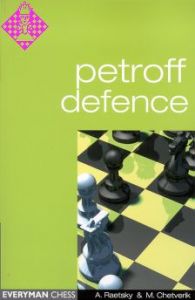 Petroff Defence€18.50
Petroff Defence€18.50 -
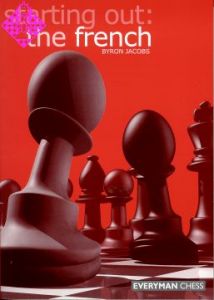 Starting Out:The French€18.95
Starting Out:The French€18.95 -
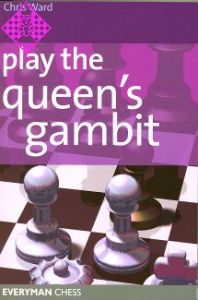 Play the Queen's Gambit€18.50
Play the Queen's Gambit€18.50 -
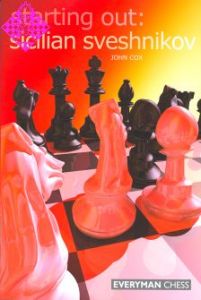 Sicilian Sveshnikov€18.95
Sicilian Sveshnikov€18.95 -
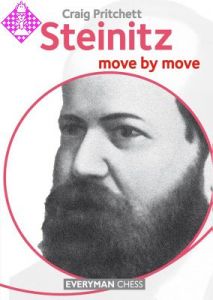 Steinitz: Move by Move€22.50
Steinitz: Move by Move€22.50 -
 The Scandinavian€22.50
The Scandinavian€22.50 - More from Everyman

